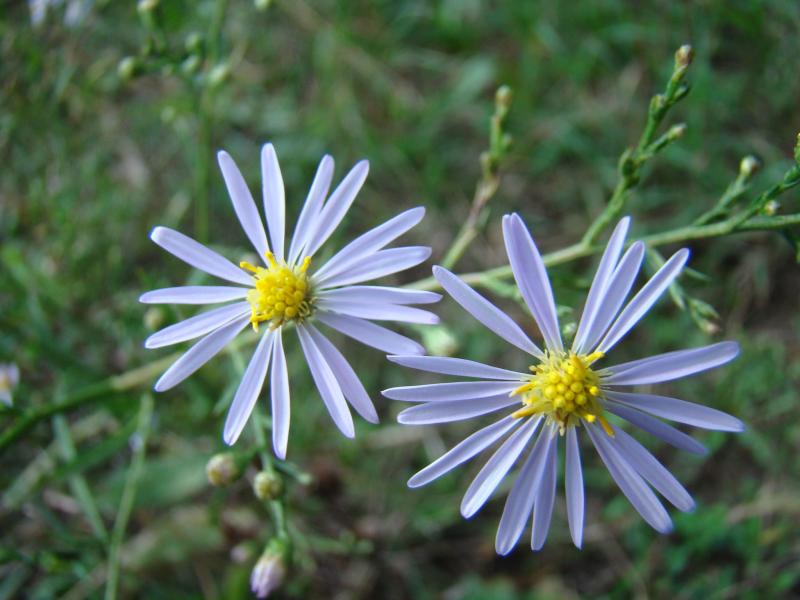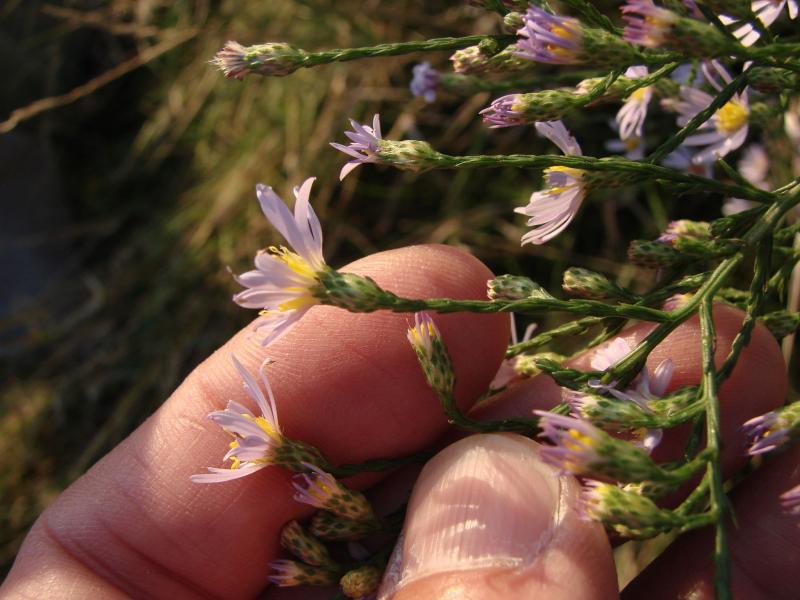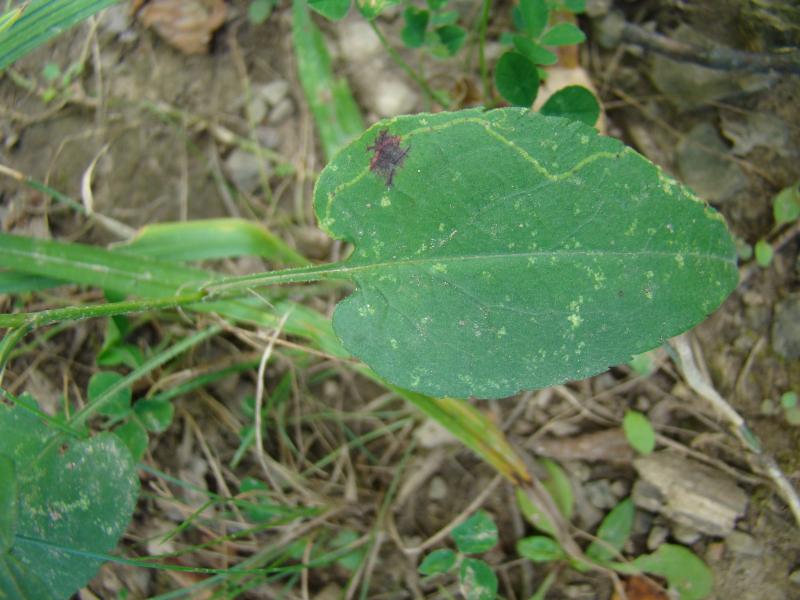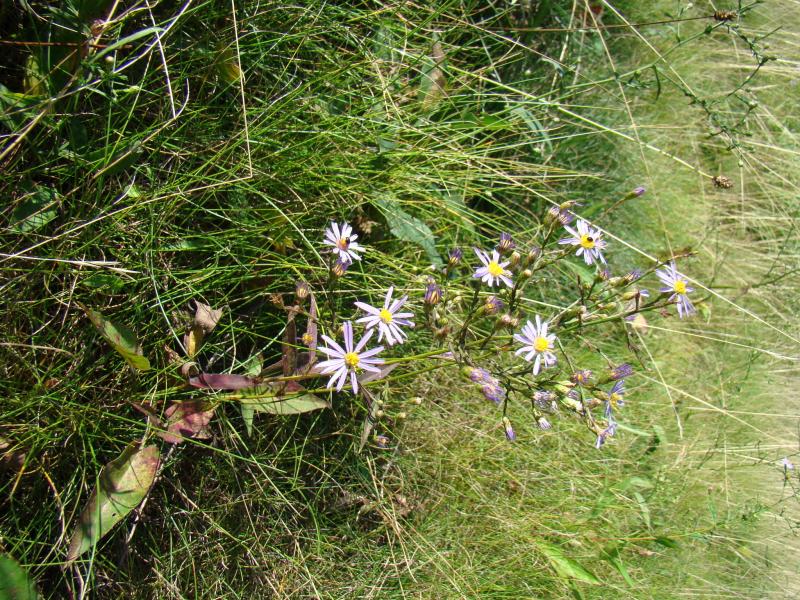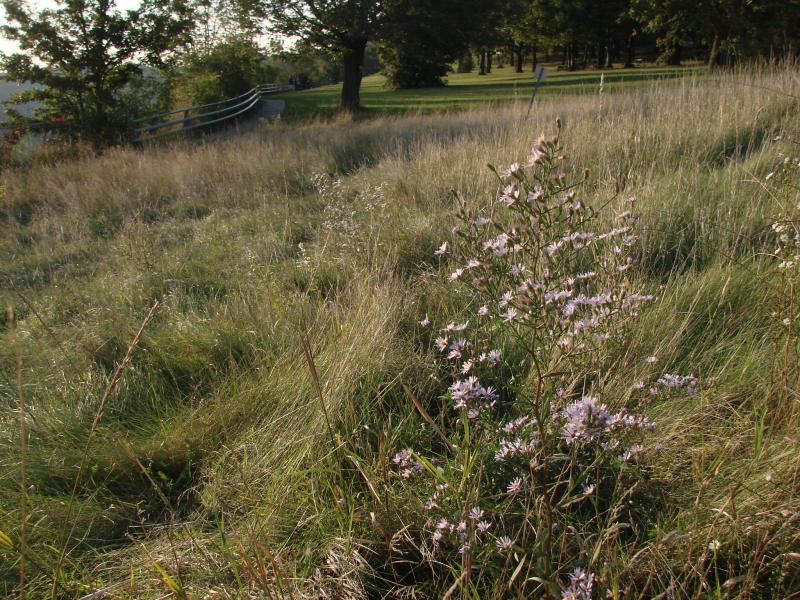Sky-blue Aster
Symphyotrichum oolentangiense (Riddell) Nesom
- Class
- Dicotyledoneae (Dicots)
- Family
- Asteraceae (Aster Family)
- State Protection
- Endangered
Listed as Endangered by New York State: in imminent danger of extirpation in New York. For animals, taking, importation, transportation, or possession is prohibited, except under license or permit. For plants, removal or damage without the consent of the landowner is prohibited.
- Federal Protection
- Not Listed
- State Conservation Status Rank
- S1
Critically Imperiled in New York - Especially vulnerable to disappearing from New York due to extreme rarity or other factors; typically 5 or fewer populations or locations in New York, very few individuals, very restricted range, very few remaining acres (or miles of stream), and/or very steep declines.
- Global Conservation Status Rank
- G5
Secure globally - Common in the world; widespread and abundant (but may be rare in some parts of its range).
Summary
Did you know?
This beautiful aster was originally described in 1835 by botanist John Leonard Riddell and named Aster oolentangiensis after the Olentangy River in Ohio where he found it near Worthington, Ohio. Riddell misspelled the river name with two Os and thus the species has that spelling. Its name was later changed to Aster azureus to reflect its sky blue flower color. When the genus was changed to Symphyotrichum the older species name had precedence.
State Ranking Justification
There is one large existing population with hundreds of plants and another population with just one plant which is probably extirpated. There are three historical occurrences from 1888 to 1936 but they are also probably extirpated.
Short-term Trends
The large population has been fairly stable over time although it was reduced at one time by excessive mowing.
Long-term Trends
The large population has been fairly stable over time although it was reduced at one time by excessive mowing.
Conservation and Management
Threats
Excessive mowing of the plants have reduced populations in the past.
Conservation Strategies and Management Practices
Keep areas open but prevent succession by mowing every one or two years in the fall after seed has dispersed.
Research Needs
Research is needed to see if the large population can be augmented by seed propagation.
Habitat
Habitat
The two known extant sites for Sky-blue Aster in New York are in grassy or herb-dominated openings within upland forests, with calcareous or at least somewhat rich soils (New York Natural Heritage Program 2013). Open, dry, sandy, loamy, or rocky soils, dry to wet (seasonally drying) prairies, alvars, glades, bluffs, dunes, barrens, open deciduous woods, oak and/or pine savannas (FNA 2006). Prairies and dry open woods (Gleason and Cronquist 1991).
Associated Ecological Communities
- Calcareous talus slope woodland
(guide)
An open or closed canopy community that occurs on talus slopes composed of calcareous bedrock such as limestone or dolomite. The soils are usually moist and loamy; there may be numerous rock outcrops.
- Mowed roadside/pathway*
A narrow strip of mowed vegetation along the side of a road, or a mowed pathway through taller vegetation (e.g., meadows, old fields, woodlands, forests), or along utility right-of-way corridors (e.g., power lines, telephone lines, gas pipelines). The vegetation in these mowed strips and paths may be dominated by grasses, sedges, and rushes; or it may be dominated by forbs, vines, and low shrubs that can tolerate infrequent mowing.
- Rich mesophytic forest
(guide)
A hardwood or mixed forest that resembles the mixed mesophytic forests of the Allegheny Plateau south of New York but is less diverse. It occurs on rich, fine-textured, well-drained soils that are favorable for the dominance of a wide variety of tree species. A canopy with a relatively large number of codominant trees characterizes this forest. Canopy codominants include five or more of the following species: red oak, red maple, white ash, American beech, sugar maple, black cherry, cucumber tree, and black birch.
* probable association but not confirmed.
Associated Species
- Acer saccharum (sugar maple)
- Achillea millefolium (yarrow)
- Amphicarpaea bracteata (hog peanut)
- Andropogon gerardii
- Anemone cylindrica (long-headed anemone)
- Asclepias tuberosa (butterfly-weed)
- Berberis thunbergii (Japanese barberry)
- Carex blanda (eastern woodland sedge)
- Celastrus scandens (American bittersweet)
- Eurybia
- Fraxinus americana (white ash)
- Hamamelis virginiana (witch-hazel)
- Helianthus divaricatus (woodland sunflower)
- Hypericum perforatum
- Ionactis linariifolius
- Maianthemum racemosum
- Panicum virgatum (switch grass)
- Poa compressa (flat-stemmed blue grass, Canada blue grass)
- Quercus alba (white oak)
- Quercus rubra (northern red oak)
- Rhamnus cathartica (European buckthorn)
- Schizachyrium scoparium
- Scutellaria parvula
- Sericocarpus
- Solidago
- Sorghastrum nutans (Indian grass)
- Tilia americana
- Vitis riparia (river grape, frost grape)
Range
New York State Distribution
Sky-blue aster is known from Livingston, Niagara, and Oneida Counties. There are also historical records from Cattaraugus and Suffolk Counties.
Global Distribution
Sky-blue Aster's range is mostly within the Mississippi Valley, extending in the north from Pennsylvania and New York to Ontario and Minnesota, and in the south from Texas east to Florida.
Identification Comments
General Description
Symphyotrichum oolentangiense is a native perennial that grows in erect, dense clumps of 1 to 5 or more stems reaching up to 1.5 m tall. The plants are short-rhizomatous or have branched, woody stems and roots. Away from the flower arrays the stems vary from being nearly smooth (glabrate) to covered with stiff, short hairs (hispidulous), within the arrays the stems bear either minute, long, soft straight hairs (pilosulous) or straight stiff, sharp appressed hairs (strigillose). Leaves are mostly concentrated towards the lower stem and are thick and firm, with entire or toothed margins, are variously hairy on both surfaces, and typically wither by flowering. The lower leaves are distinctive with long, often winged stalks with expanded, heart-shaped bases and scabrous upper surfaces. The upper leaves are lance-like and stalkless but do not clasp the stem. As with all asters, the infloresences are arranged radially into "heads" of many separate ray and disc flowers, with each head superficially resembling a single flower. The flowering heads of Sky-blue Aster are borne in open, loose, narrowly-branched, stiffly upright, more or less pyramidal clusters. The heads are 19 to 34 mm across and have 10 to 25 usually pale to azure blue to violet-purple (rarely rosy, white or bluish white), ray petals. The whorls of bracts (involucres) enclosing the flower base are bell-shaped to elliptic bell-shaped and 4.5 to 8 mm long. The individual involcral bracts (phyllaries) are in (3-)4-6 series, lying flat (appressed) or slightly spreading with a distinct dark diamond-shaped tip. The fruits are dull purple or stramineous with purple streaks, oblong-egg-shaped (obovoid) and more or less compressed. They are 1.8-2 mm long and 4-5-nerved, and smooth (glabrate) to sparsely covered with short stiff hairs and tipped with cream or slightly rose-tinged hair tufts (pappi) 3-4 mm long (Brouillet et al 2006).
Identifying Characteristics
Symphyotrichum oolentangiense is a native perennial that grows in erect, dense clumps ( of 1 to 5+ stems reaching up to 1.5 m tall. The plants are short-rhizomatous or have branched, woody stems and roots. Away from the flower the stems vary from being nearly smooth (glabrate) to covered with stiff, short hairs (hispidulous), while within the arrays the stems bear either minute, long, soft straight hairs (pilosulous) or straight stiff, sharp appressed hairs (strigillose). Leaves are present mostly towards the lower stem. They are thick, firm, with entire or toothed margins, are variously hairy on both surfaces and typically wither by flowering. The lower leaves are distinctive with long, often winged stalks with expanded sheathing bases. The leaves have a very rough (scabrous) upper surface, and typically a heart-shaped base. The upper leaves are lance-like and stalkless but do not clasp the stem. 15 to 25 mm wide s with all asters, the infloresences are arranged radially into "heads" of many separate ray and disc flowers, superficially resembling a single flowerThe flowering heads are borne in open, loose, narrowly-branched, stiffly upright, more or less pyramidal shaped clusters (arrays). The flowering heads (19 to 34 mm across) have 10 to 25 usually pale to azure blue to violet-purple, rarely rosy, white or bluish white, ray petals (corollas). The whorls of bracts (involucres) enclosing the flower base are bell-shaped to elliptic bell-shaped and 4.5 to 8 mm long. The individual bracts (phyllaries) are in (3-)4-6 series, lying flat (appressed) or with the outer slightly spreading with a distinct darker (green) diamond-shaped tip. The fruits (cypselae) are dull purple or stamineous with purple streaks, oblong-egg-shaped (obovoid) and more or less ± compressed. They are 1.8-2 mm long and 4-5-nerved, and smooth (glabrate) to sparsely covered with short stiff hairs (strigose) and tipped with cream or slightly rose-tinged hair tufts (pappi) 3-4 mm long. (Brouillet et al 2006)
Best Life Stage for Proper Identification
Entire flowering or fruiting plants are needed for identification.
Similar Species
Symphyotrichum laeve has sessile, smooth, glabrous leaf faces in contrast to S. oolentangiense's stalked and noticeably rough and hairy leaves. Symphyotrichum concolor has sessile lower leaves S. cordifolium is more compact and has leaves with more deeply lobed bases, and is generally a forest species while S. oolentangiense is associated with more open sites.
Best Time to See
Skyblue aster typically flowers mid-August through late September, the fruits are typically present beginning in early October may persist into mid-November.
- Flowering
- Fruiting
The time of year you would expect to find Sky-blue Aster flowering and fruiting in New York.
Sky-blue Aster Images
Taxonomy
Sky-blue Aster
Symphyotrichum oolentangiense (Riddell) Nesom
- Kingdom Plantae
- Phylum Anthophyta
- Class Dicotyledoneae
(Dicots)
- Order Asterales
- Family Asteraceae (Aster Family)
- Order Asterales
- Class Dicotyledoneae
(Dicots)
- Phylum Anthophyta
Synonyms
- Aster azureus Lindl.
- Aster oolentangiensis Riddell
- Aster shortii Lindl. [of NY reports, not Lindl.]
- Symphyotrichum oolentangiense var. oolentangiense
Comments on the Classification
This was changed in the Asteraceae volume 20 of Flora North America and the NY Flora Atlas. All varieties are now in synonomy with the species.
Additional Resources
Best Identification Reference
Brouillet, L., J.C. Semple, G.A. Allen, K.L. Chambers, and S.D. Sundberg. 2006. Symphyotrichum Nees. Pages 465-539 in Flora of North America Editorial Committee (Editors), Flora of North America, North of Mexico, Volume 20, Magnoliophyta: Asteridae, part 7: Asteraceae, part 2. Oxford University Press, New York, New York, USA.
Other References
Gleason, Henry A. and A. Cronquist. 1991. Manual of Vascular Plants of Northeastern United States and Adjacent Canada. The New York Botanical Garden, Bronx, New York. 910 pp.
Holmgren, Noel. 1998. The Illustrated Companion to Gleason and Cronquist's Manual. Illustrations of the Vascular Plants of Northeastern United States and Adjacent Canada. The New York Botanical Garden, Bronx, New York.
Mitchell, Richard S. and Gordon C. Tucker. 1997. Revised Checklist of New York State Plants. Contributions to a Flora of New York State. Checklist IV. Bulletin No. 490. New York State Museum. Albany, NY. 400 pp.
New York Natural Heritage Program. 2024. New York Natural Heritage Program Databases. Albany, NY.
Weldy, T. and D. Werier. 2010. New York flora atlas. [S.M. Landry, K.N. Campbell, and L.D. Mabe (original application development), Florida Center for Community Design and Research http://www.fccdr.usf.edu/. University of South Florida http://www.usf.edu/]. New York Flora Association http://newyork.plantatlas.usf.edu/, Albany, New York
Weldy, Troy W. and David Werier. 2005. New York Flora Atlas. [S.M. Landry, K.N. Campbell, and L.D. Mabe (original application development), Florida Center for Community Design and Research. University of South Florida]. New York Flora Association, Albany, NY. Available on the web at (http://newyork.plantatlas.usf.edu/).
Links
About This Guide
This guide was authored by: Stephen M. Young, Elizabeth Spencer, Richard M. Ring.
Information for this guide was last updated on: April 2, 2013
Please cite this page as:
New York Natural Heritage Program. 2024.
Online Conservation Guide for
Symphyotrichum oolentangiense.
Available from: https://guides.nynhp.org/sky-blue-aster/.
Accessed July 26, 2024.
